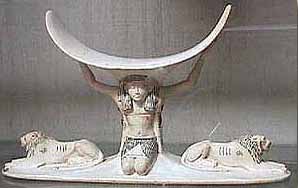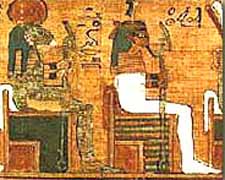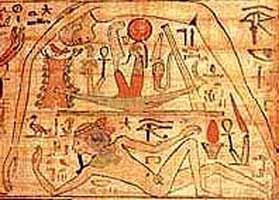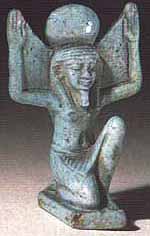

Shu (Su) was the god of dry air, wind and the atmosphere. He was also related to the sun, possibly as an aspect of sunlight. He was the son of the creator god, father of the twin sky and the earth deities and the one who held the sky off of the earth. He was one of the gods who protected Ra on his journey through the underworld, using magic spells to ward off Ra's enemy, the snake-demon Apep. As with other protector gods, he had a darker side - he was also a god of punishment in the land of the dead, leading executioners and torturers to kill off the corrupt souls. His name might be derived from the word for dryness - shu, the root of words such as 'dry', 'parched', 'withered', 'sunlight' and 'empty'. His name could also mean 'He who Rises Up'.

He was generally depicted as a man wearing an ostrich feather headdress, holding a sceptre and the ankh sign of life. Sometimes he is shown wearing the sun disk on his head, linking him to the sun. Occasionally, when shown with his sister-wife Tefnut, he is shown in lion form and the two were known as the "twin lion gods". At other times, he was shown with the hind part of a lion as his headdress, linking him to his leonine form. Mostly, he was shown with his arms raised, holding up the goddess Nut as the sky, standing on the body of Geb. One story says that Shu and Tefnut went to explore the waters of Nun. After some time, Ra believed that they were lost, and sent the his Eye out into the chaos to find them. When his children were returned to him, Ra wept, and his tears were believed to have turned into the first humans. Shu was created by asexually or by spitting, the first born of the sun god. He seems to be more of a personification of the atmosphere rather than an actual god.

- Spell 80, Coffin Texts
As a god of the wind, the people invoked him to give good wind to the sails of the boats. It was he who was the personification of the cold northern winds; he was the breath of life - the vital principle of all living things. His bones were thought to be clouds. He was also called to 'lift up' the spirits of the dead so that they might rise up to the heavens, known as the 'light land', reached by means of a giant 'ladder' that Shu was thought to hold up.
-Myth and Symbol in Ancient Egypt, R. T. Rundle Clark

Despite being a god of sunlight, Shu was not considered to be a solar deity. He was, though, connected to the sun god as one who was thought to bring Ra (and the pharaoh) to life each morning, raising the sun into the sky. During his travels through the underworld, he protected Ra from the snake-demon Apep, with spells to counteract the serpent and his followers. He participated in the judgement of the deceased in the Halls of Ma'ati as the leader of aggressive, punishing beings who were to eliminate the ones not worthy of the afterlife.
The chapter of not going into the block: Saith Osiris Ani: "The four bones of my neck and of my back are joined together for me in heaven by Ra, the guardian of the earth. This was granted on the day when my rising up out of weakness upon my two feet was ordered, on the day when the hair was cut off. The bones of my neck and of my back have been joined together by Set and by the company of the gods, even as they were in the time that is past; may nothing happen to break them apart. Make ye [me] strong against my father's murderer. I have gotten power over the two earths. Nut hath joined together my bones, and [I] behold [them] as they were in the time that is past [and I] see [them] even in the same order as they were [when] the gods had not come into being in visible forms. I am Penti, I, Osiris the scribe Ani, triumphant, am the heir of the great gods."
The Book of the Dead, Chapters XLVI and XL
He also was believed to hold up Nut, the sky goddess and his daughter, above his son the earth god Geb. Without Shu holding the two apart, the Egyptians believed that there would be no area in which to create the life they saw all around them. The Egyptians believed that there were also pillars to help Shu lift up the sky - these pillars were on the four cardinal points, and were known as the 'Pillars of Shu'.
The Speech of Anubis (from the Papyrus of Nebseni)
The Egyptians believed that Shu was the second divine pharaoh, ruling after Ra. Apep's followers, though, plotted against him and attacked the god at his palace in At Nub. Despite defeating them, Shu became diseased due to their corruption, and soon even Shu's own followers revolted against him. Shu then abdicated the throne, allowing his son Geb to rule, and Shu himself returned to the skies.
-The Chapter of Giving Air in Khert-Neter -- The Book of the Dead
There are no known temples to Shu, but despite Akenaten's distaste for the gods of Egypt, he and Nefertiti used Tefnut and Shu for political purposes. They depicted themselves as the twin gods in an apparent attempt to elevate their status to that of being a living god and goddess, the son and daughter of the creator, on earth. Akenaten, not the monotheist that most believe him to be, put out the belief that Shu lived in the sun disk. At Iunet (Dendera), though, there was a part of the city known as "The House of Shu" and at Djeba (Utes-Hor, Behde, Edfu) there was a place known as "The Seat of Shu". He was worshiped in connection with the Ennead at Iunu, and in his lion form at Nay-ta-hut (Leontopolis).Ê

Shu was the husband of his twin, the goddess Tefnut, son of the sun god Atem-Ra and father to the earth god Geb and the sky goddess Nut. As such, he was one of the gods of the Ennead. Shu was identified with the Meroitic god Arensnuphis, known as Shu-Arensnuphis. He was also identified with the war god Onuris, known as Onuris-Shu.
His links with Onuris are probably because the two gods had wives who took the form of a lioness (Mehit was the wife of Onuris), and both gods were thought to have brought their consorts back from Nubia. In Shu's case, when Tefnut went off in anger to Nubia, Ra sent both him and Thoth to get her, and they found her in Begum. Thoth began at once to try and persuade her to return to Egypt. In the end Tefnut (with Shu and Thoth leading her) made a triumphant entry back into Egypt, accompanied by a host of Nubian musicians, dancers and baboons.
Egypt's second divine ruler, Shu was one of the great Ennead. A god of the wind, the atmosphere, the space between the sky and the earth, Shu was the division between day and night, the underworld and the living world. He was a god related to living, allowing life to flourish in Egypt with his breath of life. He was the bridge between life and death, both a protector and a punisher in the afterlife. To the Egyptians, if there was no Shu, there would be no life - Egypt existed thanks to Shu.